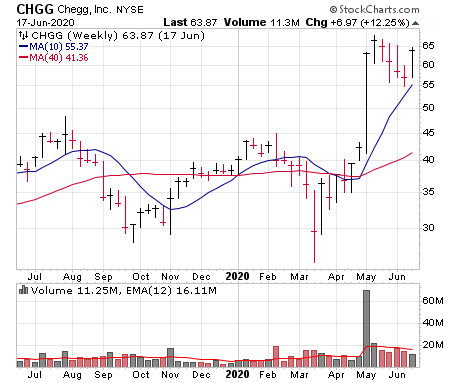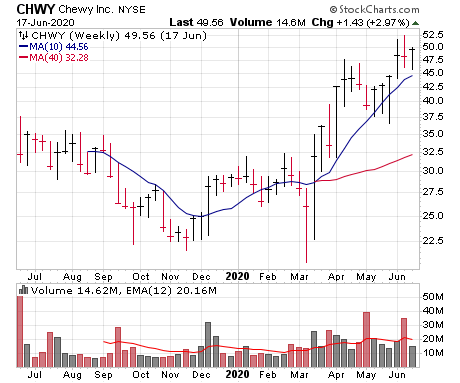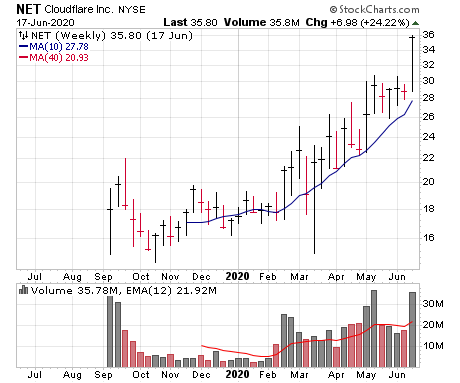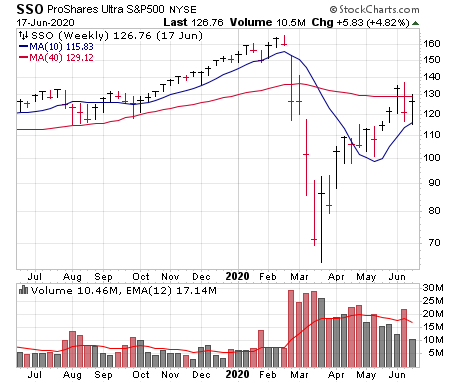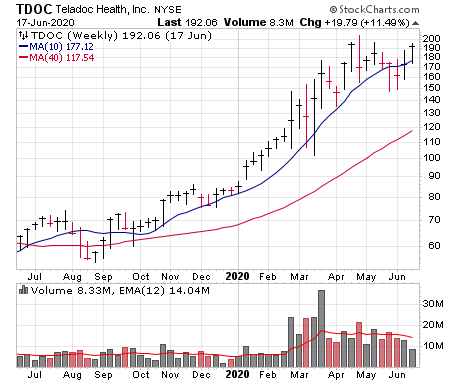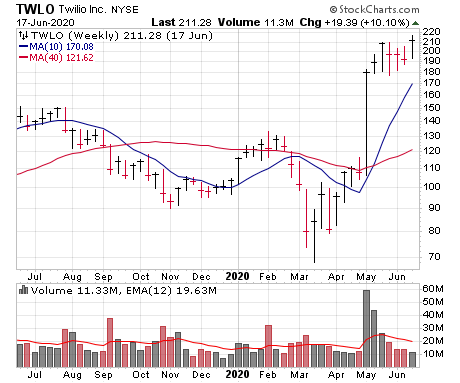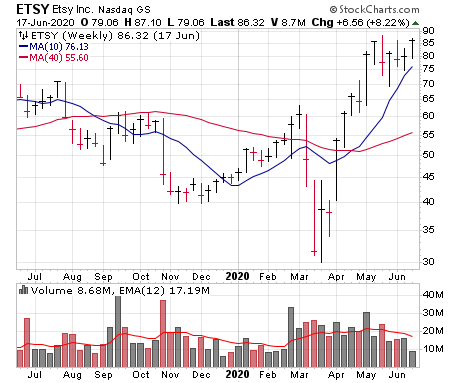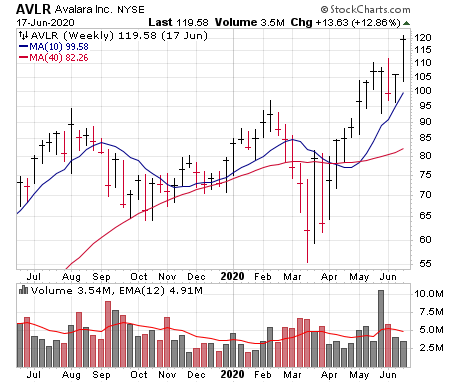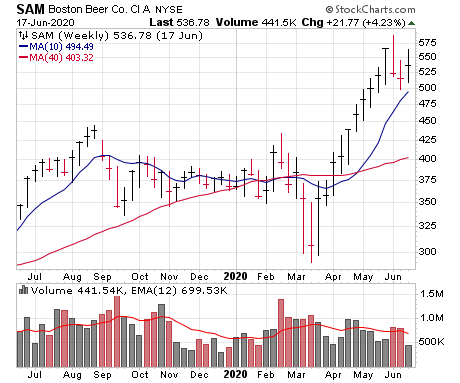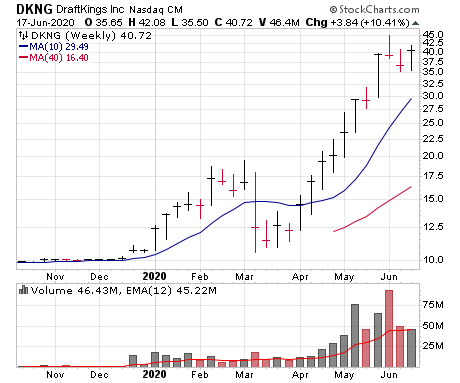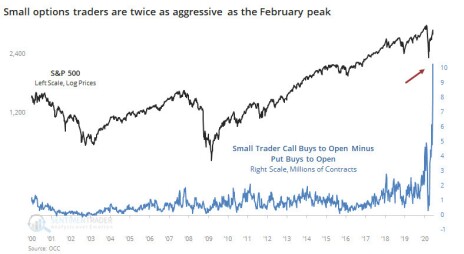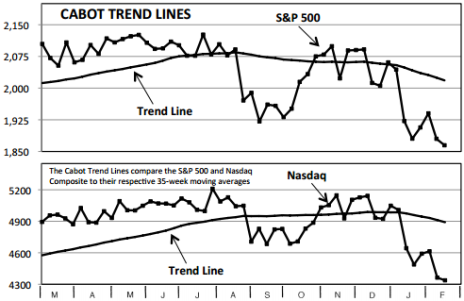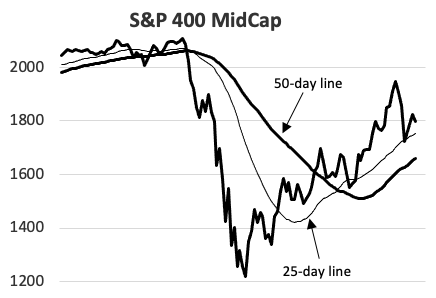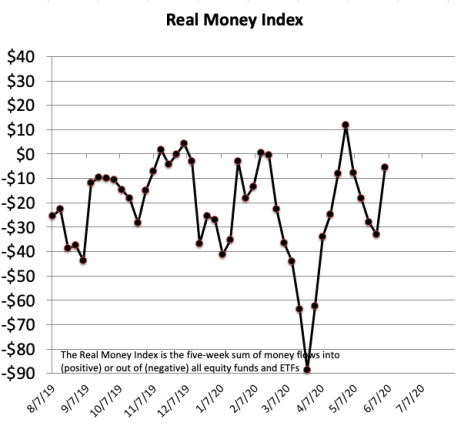There remain some yellow flags in the market, but when you look at the big picture, there remains far more good than bad. It’s vital to remain flexible of course, as in 2020, things have changed on a dime a couple of times, but with most of the evidence still positive, we remain mostly bullish.
Cabot Growth Investor 1448
[premium_html_toc post_id="208137"]
Much More Good than Bad
We believe it was the late, great Marty Zweig who once wrote that, in the world of the market, you’re never going to get everything lined up in one direction—if you had 100 market timing indicators, to get 85 or 90 of them pointing bullish or bearish would be highly unusual. (Note: You should never have so many—all you need are a few trusty ones, like ours.) Instead, the market is an odds game; if the weight of the evidence is positive, you go with it, while still monitoring the few yellow flags that are almost always out there.
Take today, for instance, where there remains a ton of uncertainty and doubt, starting with the macro-economic picture and fears of a second virus wave in certain places of the country. Even looking at the market, there are many things to worry about—the rally in the broad market has hit a major pothole during the past two weeks, the Nasdaq itself has gotten a lot more volatile after a big advance (buyers and sellers are fighting it out) and some sentiment measures tell us small investors have gotten euphoric (see our write-up later in this issue on our sentiment take).
Flexibility has been the #1 trait of top-performing investors this year, so you have to be open to any possibility. The above worry signs are all worth paying attention to and, if confirmed by the action of the market and leading stocks, could be worth taking defensive action on.
But, to this point, they haven’t been confirmed by the market—the primary evidence (trends of the major indexes and action of leading stocks) are both positive. And much secondary evidence is encouraging, too: Our Aggression Index (the relative performance of the growth-oriented Nasdaq vs. the “safe” consumer staples sector) remains firmly positive, telling us that big investors are taking on risk and not looking for cover. Moreover, our old Two-Second Indicator (number of new lows on the NYSE) is still in great shape, with just one reading over 10 during the past month!
Of course, all of this is descriptive and not predictive; nothing says the market can’t turn tail here and have a “real” correction. Again, be flexible! But the overall picture shows far more good than bad, so we remain bullish until proven otherwise.
What To Do Now
Continue to follow the plan—holding your strong performers and putting money to work as opportunities arise. In the Model Portfolio, we’re adding a full position in Wingstop (WING) today, which looks to be at a solid entry point. Our cash position will now be around 10%.
Model Portfolio Update
It’s been a choppy past few weeks for the Model Portfolio, first as growth stocks hit some potholes and then last week when the entire market wobbled. But while a few leaks sprung up and crazy volatility is the norm, our market timing indicators remained positive and growth stocks have perked back up. Translation: While there have been some gut punches, the evidence has remained positive. In tonight’s issue, we’re adding Wingstop (WING), which is showing signs of resuming its advance after a rest period.
Current Recommendations
| Stock | No. of Shares | Portfolio Weightings | Price Bought | Date Bought | Price on 6/18/20 | Profit | Rating |
| Chegg (CHGG) | 1,216 | 5% | 65 | 5/22/20 | 63 | -2% | Buy a Half |
| Chewy (CHWY) | 1,595 | 5% | 45 | 4/20/20 | 48 | 8% | Hold a Half |
| Cloudflare (NET) | 5,424 | 10% | 26 | 4/20/20 | 37 | 40% | Buy |
| Dexcom (DXCM) | 290 | 7% | 216 | 11/15/19 | 402 | 86% | Hold |
| DocuSign (DOCU) | 982 | 10% | 65 | 9/13/19 | 162 | 149% | Hold |
| Okta (OKTA) | 947 | 11% | 150 | 4/20/20 | 196 | 31% | Buy |
| ProShares Ultra S&P 500 (SSO) | 1,306 | 10% | 120 | 5/29/20 | 127 | 6% | Buy |
| Teladoc (TDOC) | 631 | 7% | 78 | 11/01/19 | 192 | 145% | Buy |
| Twilio (TWLO) | 830 | 10% | 174 | 5/8/20 | 215 | 24% | Buy |
| Vertex Pharmaceuticals (VRTX) | 414 | 7% | 199 | 11/8/19 | 279 | 40% | Hold |
| Wingstop (WING) | New | — | — | — | 121 | — | Buy |
| CASH | $284,949 | 20% |
Chegg (CHGG 63)—CHGG came close to the edge a couple of times during the growth stock selloff, but it held near the close of its earnings day (that’s often a key level for big earnings gappers) and has begun to rebound nicely, bolstered by news of a $500 million share buyback. Fundamentally, we also like the firm’s acquisition of Mathway for $100 million earlier this month; the company has a very popular (used in about 100 countries) and comprehensive (400 math topics; solved more than 1.3 billion problems last year) app that should meaningfully expand the firm’s target market. Bottom line, business is good and getting better, and the stock is rebounding nicely after a four-week dip. We are near breakeven, which is good compared to where we were, but not enough to fill out our position. If you own some, hold on, and if you don’t, we’re OK buying a half-sized stake (for us, that’s 5% of the portfolio) here or on dips. BUY A HALF.
Chewy (CHWY 48)—CHWY had run up to new highs ahead of earnings, so it’s not surprising that it backed off a bit despite a very solid quarterly report that featured 46% revenue growth (up 40% even excluding stockpiling demand) and had management meaningfully hiking guidance (including a breakeven year of EBITDA, pulling forward the path to profitability by a year or more), partially because all of the new customers it acquired (15 million active customers, up 33% from a year ago) are showing higher-than-normal purchasing trends. (CEO Sumit Singh: “We believe the increased demand levels we are experiencing are here to stay and reflect an acceleration of e-commerce adoption that is not likely to return to pre-pandemic levels.”) As we’ve written before, Chewy seems like “just” a pet food company, but to us, it’s a follow-on play to many big winners that benefited as entire industries (movie watching, airline/hotel ticket buying, etc.) moved online. As for the stock, the four days of post-earnings selling has been normal and shares have begun to find support. For now, we’ll stay on Hold, but a couple more days of stabilization (especially as the 50-day line, now near 44, continues to catch up) could have us filling out our position. HOLD A HALF.
Cloudflare (NET 37)—Every day investors and the media focus on stocks making big moves and that are in the news, but you’ll often do better if you hunt for names that are quieting down after strong rallies. NET was a perfect example; after a string of wild weeks, the stock tightened up for a month, which is usually indicative that big investors are picking up shares in a certain price zone. And this week has shown the result, as the stock has catapulted to new highs on massive volume (Wednesday was the stock’s largest volume in history), helped by some soothing words from analysts and overall bullishness for the company’s advanced cloud network, usage of which should pick up as cloud and e-commerce activities accelerate and as companies of all sizes look for better network security, access and performance. Given that NET just got going earlier this year, the odds favor it being early in its overall advance, though the huge advance this week could easily lead to a shake or two in the days or weeks ahead. If you own some, we advise hanging on, though if you don’t, consider buying a smaller position or looking for dips. We’re raising our mental stop into the 26 to 27 area, which isn’t far below our cost basis. BUY.
Dexcom (DXCM 402)—Abbott Laboratories got FDA approval for its next-generation Libre 2 continuous glucose monitor this week; such competitive headlines in the past would have sent DXCM reeling for a few days, but that hasn’t happened this time around. Part of the reason: Big investors continue to come around to the view that CGMs are in the early phases of a huge growth wave. One analyst this week said that, just in its current market, Dexcom could triple its revenue over the next five years, while the non-core markets (non-intensive Type 2, hospital use, etc.) could be a $15 billion total opportunity over time (obviously Dexcom would get a slice of this, not the whole pie; the firm’s revenues in the past year are around $1.4 billion). Thus, the story remains big, and after a couple of successful tests of the 50-day line (now around 359), the stock is perking up again, albeit on light volume. Hold on tightly to your shares. HOLD.
DocuSign (DOCU 162)—DOCU has continued its amazing run, goosed not just by the renewed buying in growth titles but news that it will join the Nasdaq 100 (it will go into the index next Monday, June 22). Similar to S&P 500 additions, these announcements tend to cause a short-term pop, though after the addition, a retrenchment isn’t unusual. We’re happy to ride the stock higher for as long as it wants to run, and long-term, we still think there’s a good chance DOCU will morph into a core holding of hundreds of big funds thanks to its foreseeable growth outlook. But given how extended it is on an intermediate-term basis (more than 30% above its 50-day line; 90% above its 200-day line; up 175% from its breakout last September), we’re not overly interested in piling in here. HOLD.
Okta (OKTA 196)—Okta’s up-and-down action was tedious in late May (196 to 168) and early June (205 to 173), but it wasn’t abnormal given the prior run, and now shares are beginning to perk up again. We’re not ruling out a third shakeout in the near future (the 50-day line is still just under 170), but the main trend is certainly up and this first consolidation phase after the breakout in April should give way to higher prices. As with many online stocks, Okta’s management believes the effects of the shut-in are far more than a one-time boost, with the top brass thinking the pandemic has accelerated cloud adoption by five years! That doesn’t mean it’s immune from any ill effects from the virus (there are some hard-hit industries among its client base), but there’s growing confidence that the firm’s 30%-plus revenue growth goal for the next few years (and booming free cash flow) is attainable. You can buy some here or (preferably) on dips of a few points. BUY.
ProShares Ultra S&P 500 Fund (SSO 127)—One reason we like to look at history isn’t to get an exact map of the future (that doesn’t exist), but to get an idea of what can be considered normal vs. abnormal. In this case, one interesting nugget we touched on two weeks ago was that, following a 90% Blastoff signal, the average maximum loss from that point for the S&P 500 was a mere 2% or so. And, interestingly, during the big recent selloff, the S&P fell as much as … 2.3% from its 90% signal. Obviously, that could change, and even a 3% or 4% drop below that level wouldn’t necessarily be a death knell given the market’s current volatility, but the point is the indexes are still acting “normally” in respect to the blastoff signal. Of course, SSO isn’t just a blastoff play—the fact that our Cabot Trend Lines and Cabot Tides are bullish is even more important to us. All in all, the path of least resistance remains up, so we’ll remain on Buy. BUY.
Teladoc (TDOC 192)—It’s looking like, after a six-week, 27% correction, TDOC is getting back on track. And why shouldn’t it? Telehealth is an idea whose time has come, making it easier (and safer) to see a doctor for everything from the regular sniffles to behavioral health to dermatology and much more. Teladoc’s growth has been steady (it targets between 20% and 30% organic growth), but some analysts believe that’s set to accelerate in a big way (organic growth was 40% in Q1) and, in a recent analyst week (hosted by JP Morgan), the CEO said all the right things, including that the pipeline of large multinational employers looking for global telehealth solutions (instead of domestic patches here or there) is increasing “substantially.” Back to the stock, the 200 area could prove to be tough to get through (round number resistance; it was rejected there today), and the volume on this push higher has been just OK. Even so, while some near-term wobbles are always possible, we think the uptrend is beginning to reassert itself. We’ll go back to Buy, though dont’ be shocked to see dips of few points. BUY.
Twilio (TWLO 215)—TWLO was sitting at 122 before earnings in early May; less than a month later, it was at 210 following a tremendous gap and upside follow through, and so far, the stock was only able to shake out as low as 177 during the worst of the growth stock selling—a strong sign that big investors want in. Analysts have been hopping on the bandwagon as digital adoption trends accelerate, with one pundit thinking the firm’s revenues could triple over the next five years. There are no sure things in the market, but the stock’s controlled dip after a huge, big-volume advance bodes well—TWLO continues to look like a relatively fresh liquid leader. We’ll stay on Buy, though as with many stocks that have lifted lately, some modest dips wouldn’t be surprising. BUY.
Vertex Pharmaceuticals (VRTX 279)—We moved Vertex to hold last week, not because it had done anything terribly wrong, but just because the stock was beginning to lag a bit—it had gone two months without any net progress, which isn’t a sin but did put it behind most growth stocks. We’re not in a hurry to sell, as Vertex’s solid, steady, predictable story from its cystic fibrosis drugs should keep big investors interested, and the firm is even getting some good news from the pipeline, with some positive early-stage results for its gene-editing therapy (in concert with CRISPR Therapeutics) for a couple of major blood disorders. Should the stock get some momentum going, we’re happy to go back to Buy, but for now we’re staying on Hold, albeit with a loose mental stop in the mid-240s. HOLD.
Wingstop (WING 121)—We have a soft spot for cookie-cutter stories, as they offer the rapid, reliable growth that big investors pine for. Wingstop offers chicken wings in a couple dozen flavors, along with fries and the like—it had 1,413 restaurants at the end of March, up 11% from a year ago, and long-term, the firm sees room for 3,000 locations in the U.S. and another 3,000 overseas. Long-term, the goal is to be a top-10 global restaurant chain! Wingstop was already digitally-savvy and takeout-oriented heading into COVID (80% of business was takeout or delivery before the crisis), and that’s helped in a big way—Q1 was solid (sales up 15%, including same-store sales up 10%), and April’s same-store sales rose more than 30%. Nobody expects that growth rate to continue, but the big idea is that Wingstop already had a huge opportunity and the story has only picked up steam of late. As for the stock, it won’t be the fastest mover, but after a huge recovery and calm five-week rest, we think it’s close to resuming its advance (though again, another shakeout is possible). Be aware that the stock can trade thinly, so try not to place overnight orders. Our loss limit will be in the low 100s. BUY.
Watch List
- Datadog (DDOG 87): Datadog certainly seems like it has the makings of a leading glamour stock, with the story, numbers and chart of a big winner. Its first meaningful pullback should provide a solid opportunity.
- Peloton (PTON 51): As the leader in connected fitness, we think Peloton has huge potential. It continues to trend up, but we’re more interested in nibbling on a shakeout if/when it occurs.
Other Stocks of Interest
The stocks below may not be followed in Cabot Growth Investor on a regular basis. They’re intended to present you with ideas for additional investment beyond the Model Portfolio. For our current ratings on these stocks, see Updates on Other Stocks of Interest on the subscriber website or email mike@cabotwealth.com.
Etsy (ETSY 87)—Etsy is the Amazon of homemade and unique goods of all kinds that’s attracted 47.7 million active buyers (up 16% from a year ago) and 2.8 million active sellers (up 26%). The firm had a big run into early 2019, but then invested a ton in better web, search and marketing capabilities for its sellers, and to expand its selection to have offerings on its site that appeal to every special occasion and holiday. Ironically, that investment was part of the reason for what turned into a year-long slump, as earnings and cash flow growth slowed, but (a) that should be transitory, as key metrics (gross merchandise volume (GMV) and others) still look fine, and (b) the shut-in has goosed business, and like many online retailers, that pickup should stick. In Q1, sales rose 35% and GMV was up 32%, though earnings fell and EBITDA rose just 10% (again, investments crimped the bottom line). But the virus should be good for business going forward—in April, GMV was up 130% from a year ago, and while nobody expects that pace to keep up, a lot of the new customers are likely to stick around even as the world turns right side up. ETSY had a stunning comeback from its March lows, and like most growth stocks, has rested normally for the past month-plus; it looks like its next big move is up.
Avalara (AVLR 124)—Cloud software stocks remain hit or miss; Coupa (COUP) looks like the leader in the field, but Avalara is right up there with it, both from a stock perspective (shares hit new highs this week) and because of its great, easy-to-understand story. The company’s offerings are all about tax compliance for retail outfits—because of the Wayfair decision by the Supreme Court, collecting state sales tax revenue across state lines is a must, and Avalara’s various offerings allow these firms automate the harrowing task of sales tax collections and return filings. Business was likely hit in Q2 (fewer cross-sells and upsells, plus a hit to small/mid-sized businesses) due to the shut-in, but as e-commerce has boomed, the demand for this company’s platform is only going to increase. The firm will crank out 25%-ish revenue growth for many years, and while the bottom line is in the red, it’s making steady improvement each quarter. Long story short, Avalara should produce steady, reliable growth for a long time to come—it has the potential of being a must-have service for retail firms that can’t/don’t want to build their own compliance department. AVLR has stretched higher this week. An Analyst Day on June 23 could be a catalyst.
Boston Beer (SAM 534)—Here’s a simple, well-managed growth story that’s easy to like. Boston Beer was one of the first microbreweries, as its Sam Adams beers provided an alternative to the Buds and Coors of the country many years ago, but the firm is much more than Sam Adams today, with Dogfish Head (generally hoppy IPAs), Twisted Tea (which dominates the hard tea industry with 90%-plus market share) and Truly hard seltzers all contributing to the bottom line. In fact, these newer lines are seeing the fastest growth by far. The virus shut-in has affected business (fewer restaurant sales, of course) in some ways, but in other ways it’s been a huge catalyst—alcohol sales have been booming as people head to the liquor store more, and that trend remains in place, with early June’s alcohol sales up 22% for the industry as a whole, while hard seltzer sales were up a ridiculous 235%; Boston Beer’s market share in this category doubled from pre-pandemic levels. (Hard tea has been booming, too.) While Q1’s results were hit by the shut-in, analysts see sales and earnings picking up from here, with 2021 showing earnings up 38%. SAM was one of the first to break out (mid-April) after the market bottom, and while it’s suffered some selling this month, the three-week rest looks normal so far. It’s not changing the world, but business is good and the stock is under accumulation.
New Industry, New Leadership
DraftKings (DKNG)
Gambling is an industry as old as time itself, but there have been new growth themes in the sector over time, the most recent (starting five to 10 years ago) being the move into Macau and elsewhere in Asia that caused a great bull run in many of big casinos. But those stocks are stodgy and cyclical at this point—today, a new growth theme has emerged, and it looks like DraftKings is positioned to lead the way.
The theme involves online casinos (sometimes dubbed iGaming), fantasy sports (often on a daily basis, called DFS) and sports betting in general. These offerings existed on a limited basis across the U.S. before, but adoption is picking up steam, partly as states, which are looking for more revenue in the wake of the virus disaster, are loosening the reigns and passing legislation allowing iGaming and DFS services.
As of March, 21 states representing more than one-third of the U.S. population, have legalized sports betting. At that time, DraftKings had online sportsbooks operational in seven of those states, and since then, it’s gone up in at least one more (Colorado) and recently struck a deal to enter Michigan as well. All the while, more and more states are considering legalization legislation.
iGaming could be an even larger opportunity—it’s up and running in New Jersey, and based on the uptake in that state in recent years (up 62% in 2019!), and assuming some conservative legalization metrics, DraftKings’ management thinks iGaming could be a $1 billion type opportunity in the U.S. Online sports books should be even larger ($3 billion or so), marking a $4 billion total opportunity down the road.
Of course, there will be competition, but thanks to DraftKing’s top positioning in daily fantasy sports and online sports betting so far (which gives it a leg up in data, technology brand name and analytics), most are thinking this company will emerge as the leader in the space.
Unfortunately, the story isn’t as simple as it sounds, as DraftKings has a complicated history of mergers, divestitures and combinations that make any recent sales and earnings results relatively meaningless. But some metrics (720,000 monthly users in Q1 of this year, up 16% from a year ago, while those users produced nearly 11% more revenue each) look good, and the company itself believes it can crank out cash flow of $1 billion annually given the aforementioned market assumptions down the road. As for the here and now, the firm sees revenues rising 25% this year and leaping 30% in 2021.
It’s a big story, and in a hot stock market, DKNG has had a massive run, breaking out in late April and more than doubling by the end of May before finally consolidating with most growth stocks during the past three weeks. It’s speculative for sure, but if the stock can rest for another couple of weeks (with the 10-week line catching up), it could offer a decent risk/reward entry point. WATCH.
Sentiment: Useful, but not Primary
Sentiment has been a hot topic of late, partially due to some unusual things going on. For instance, look at this chart from Jason Goephert of Sentimentrader.com, which takes the number of small call option buys and subtracts the number of small put option buys every week. (Small = 10 contracts or less.) It’s gone absolutely bananas during the past few weeks, a strong sign that, at least in the options world, greed has taken hold.
Moreover, this action is backed up by Jacob Mintz of Cabot Options Trader, who has been writing about the crazy buying in various weekly options contracts. Throw in some wild data on the number of stock trades being reported at various brokerages (again, a sign many are active in the market) and there’s growing evidence that many small fries are euphoric … something that often coincides with market tops.
However, that’s not the whole story—the AAII survey of individual investors tells us most are still scared (this week’s bullish reading is among the lowest of the year), while broader measures like money flows (our Real Money Index) certainly don’t show excessive optimism.
The split between these indicators is the reason why sentiment is useful, but is not a primary indicator—it’s inexact, and as we see today, many measures can send mixed messages. As for the here and now, we’d simply say that investor sentiment has definitely heated up after 11 strong weeks off the lows, maybe enough to deliver a “real” correction that instills a new batch of fear. But in terms of taking action, we’d stick with the rubber-meets-the-road indicators like the action of the major indexes and leading stocks.
Cabot Market Timing Indicators
There are some flies in the ointment, but at this point, the primary and most of the secondary timing indicators we follow are positive, so while we’re flexible, we’re staying bullish.
Cabot Trend Lines: Bullish
Our Cabot Trend Lines turned positive just after our last issue went to press, and this key indicator remains clearly bullish today. As of last Friday, the S&P 500 (by a slim 0.4%) and the Nasdaq (by a huge 9.6%) were both north of their respective 35-week moving averages for the third straight week. From here, there would have to be two straight closes by both indexes below their 35-week lines to generate a new sell signal. Translation: The odds favor higher prices in the months ahead.
Cabot Tides: Bullish
Our Cabot Tides are also still positive—so far, the retreat has been normal, and at this point, most indexes (including the S&P 400 MidCap, shown here) are still in good shape. There’s about 6% of daylight above the lower (50-day) moving average, giving the market some room to maneuver. Overall, both the long- and intermediate-term trends of the market are pointed up—a good reason to be heavily invested.
Cabot Real Money Index: Neutral
The Real Money Index recorded a big inflow last week (just over $20 billion), a sign that the three-month rally has finally enticed many investors back into the market, which is possibly a short-term negative. But as you can see in the chart, the five-week moving average is still subdued—overall, the indicator is neutral, meaning there hasn’t been signs yet of panic buying that often indicates risk has increased in a meaningful way.
Charts courtesy of StockCharts.com
The next Cabot Growth Investor issue will be published on July 2, 2020.
Cabot Wealth Network
Publishing independent investment advice since 1970.
CEO & Chief Investment Strategist: Timothy Lutts
President & Publisher: Ed Coburn
176 North Street, PO Box 2049, Salem, MA 01970 USA
800-326-8826 | support@cabotwealth.com | CabotWealth.com
Copyright © 2020. All rights reserved. Copying or electronic transmission of this information is a violation of copyright law. For the protection of our subscribers, copyright violations will result in immediate termination of all subscriptions without refund. No Conflicts: Cabot Wealth Network exists to serve you, our readers. We derive 100% of our revenue, or close to it, from selling subscriptions to its publications. Neither Cabot Wealth Network nor our employees are compensated in any way by the companies whose stocks we recommend or providers of associated financial services. Disclaimer: Sources of information are believed to be reliable but they are not guaranteed to be complete or error-free. Recommendations, opinions or suggestions are given with the understanding that subscribers acting on information assume all risks involved. Buy/Sell Recommendations: All recommendations are made in regular issues or email alerts or updates and posted on the private subscriber web page. Performance: The performance of this portfolio is determined using the midpoint of the high and low on the day following the recommendation. Cabot’s policy is to sell any stock that shows a loss of 20% in a bull market or 15% in a bear market from the original purchase price, calculated using the current closing price. Subscribers should apply loss limits based on their own personal purchase prices.

